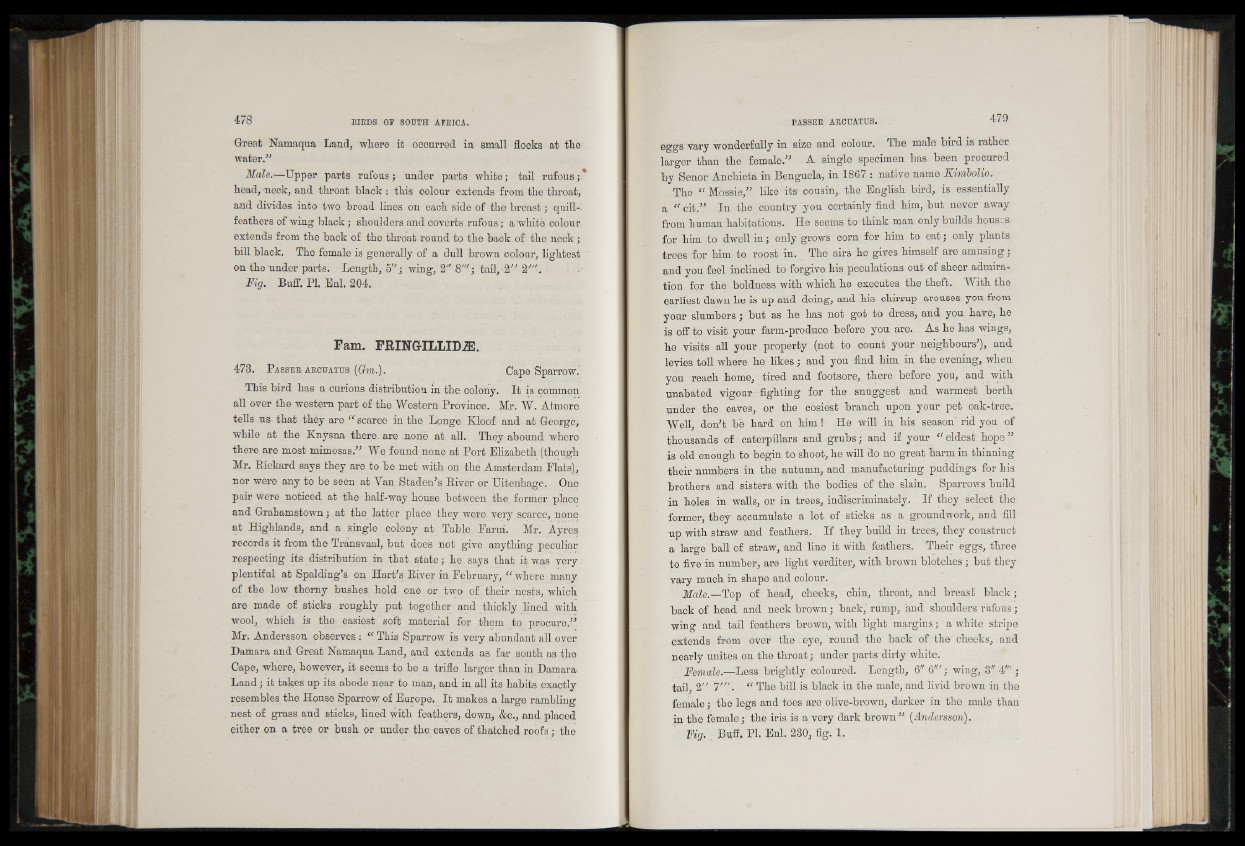
Great Namaqua Land, where it occurred in small flocks at the
water."
Male.—Upper parts rufous; under parts white; tail rufous;*
head, neck, and throat black : this colour extends from the throat,
and divides into two broad lines on each side of the breast; quill-
feathers of wing black; shoulders and coverts rufous; a white colour
extends from the back of the throat round to the back of the neck;
bill black. The female is generally of a dull brown colour, lightest
on the under parts. Length, 5"; wing, 2" 8"'; tail, 2" 2'".
Fig. Buff. PI. Enl. 204.
Fam. FRINGILLIDiE.
473. P a sser arcuatus (Gm.). Cape Sparrow.
This bird has a curious distribution in the colony. It is common
all over the western part of the Western Province. Mr. W. Atmore
tells us that they are “ scarce in the Longe Kloof and at George,
while at the Knysna there are none at all. They abound where
there are most mimosas." We found none at Port Elizabeth (though
Mr. Rickard says they are to be met with on the Amsterdam Flats),
nor were any to be seen at Yan Staden’s River or Uitenhage. One
pair were noticed at the half-way house between the former place
and Grahamstown; at the latter place they were very scarce, none
at Highlands, and a single colony at Table Farm. Mr. Ayres
records it from the Transvaal, but does not give anything peculiar
respecting its distribution in that state; he says that it was very
plentiful at Spalding’s on Hart’s River in February, “ where many
of the low thorny bushes hold one or two of their nests, which
are made of sticks roughly put together and thickly lined with
wool, which is the easiest soft material for them to procure.”
Mr. Andersson observes: “ This Sparrow is very abundant all over
Damara and Great Namaqua Land, and extends as far south as the
Cape, where, however, it seems to be a trifle larger than in Damara
Land; it takes up its abode near to man, and in all its habits exactly
resembles the House Sparrow of Europe. It makes a large rambling
nest of grass and sticks, lined with feathers, down, &c., and placed
either on a tree or bush or under the eaves of thatched roofs; the
eggs vary wonderfully in size and colour. The male bird is rather
larger than the female.” A single specimen has been procured
by Senor Anchieta in Benguela, in 1867 : native name Kimbolio.
The “ Mossie,” like its cousin, the English bird, is essentially
a “ cit.” In the country you certainly find him, but never away
from human habitations. He seems to think man only builds houses
for him to dwell in; only grows corn for him to eat; only plants
trees for him to roost in. The airs he gives himself are amusing;
and you feel inclined to forgive his peculations out of sheer admiration
for the boldness with which he executes the theft. With the
earliest dawn he is up and doing, and his chirrup arouses you from
your slumbers; but as he has not got to dress, and you have, he
is off to visit your farm-produce before you are. As he has wings,
he visits all your property (not to count your neighbours), and
levies toll where he likes; and you find him in the evening, when
you reach home, tired and footsore, there before you, and with
unabated vigour fighting for the snuggest and warmest berth
under the eaves, or the cosiest branch upon your pet oak-tree.
Well, don’t be hard on him ! He will in his season rid you of
thousands of caterpillars and grubs; and if your “ eldest hope”
is old enough to begin to shoot, he will do no great harm in thinning
their numbers in the autumn, and manufacturing puddings for his
brothers and sisters with the bodies of the slain. Sparrows build
in holes in walls, or in trees, indiscriminately. If they select the
former, they accumulate a lot of sticks as a groundwork, and fill
up with straw and feathers. If they build in trees, they construct
a large ball of straw, and line it with feathers. Their eggs, three
to five in number, are light verditer, with brown blotches; but they
vary much in shape and colour.
Male.—Top of head, cheeks, chin, throat, and breast black;
back of head and neck brown; back,' rump, and shoulders rufous;
wing and tail feathers brown, with light margins; a white stripe
extends from over the eye, round the back of the cheeks, and
nearly unites on the throat; under parts dirty white.
Female.—Less brightly coloured. Length, 6" 6'” ; wing, 3" 4"';
tail, 2" 7"'. “ The bill is black in the male, and livid brown in the
female; the legs and toes are olive-brown, darker in the male than
in the female; the iris is a very dark brown ” (Andersson).
Fig. ; Buff. FI. Enl. 230, fig. 1,